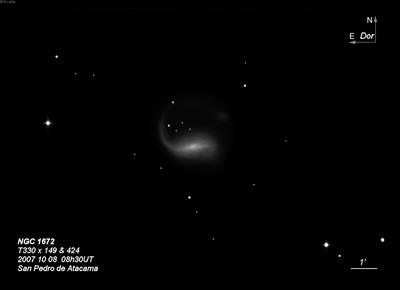
James Dunlop discovered NGC 1672 = D 296 on 5 Nov 1826 and described "a faint ill-defined nebula, with a small bright point in the preceding side, which I suspect to be a star; there are several similar small stars in the field." His position was off by 15' to the NW. John Herschel, who made two observations of this barred spiral, was uncertain if D 296 was equivalent to h2665. On the first sweep he logged "B, L, pmE, svmbM to a nucleus; 2.5' long, 1.5' broad; a star 12th mag involved." His position was accurate.
Joseph Turner sketched NGC 1672 on 5 Dec 1876 with the 48" Great Melbourne Telescope but there was no indication of spiral structure (unpublished lithograph plate II, figure 16).
300/350mm - 13.1" (2/19/04 - Costa Rica): fairly bright, fairly large, elongated 3:2 ~E-W, ~3'x2'. Sharply concentrated with a very small, bright core, ~20" diameter, and a large oval halo. Spiral structure was evident as an ill-defined extension or haze off the NE side, though I could not resolve this spiral arm clearly. Situated directly between two mag 9 stars 10' SW and 6.5' ENE. Located 30' NNE of mag 5.3 Kappa Doradus. This galaxy is a member of the Dorado group, which includes NGC 1515, NGC 1533, NGC 1536, NGC 1543, NGC 1546, NGC 1553, NGC 1566, NGC 1574, NGC 1596, NGC 1617 and IC 2056. Possible additional members include NGC 1559, NGC 1602, NGC 1672, NGC 1688, NGC 1703 and NGC 1705.
400/500mm - 18" (7/8/02 - Magellan Observatory, Australia): this striking spiral galaxy appeared fairly bright and large, ~4' diameter, sharply concentrated with a very bright core. Clearly emerging from the east side of the oval core or bar was a spiral arm which curled north and wrapped around two stars to the NW of the core. The extension on the west side was just a very faint, diffuse haze on the SW side without a sharply defined arm structure. A mag 9 star is 6.5' ENE and a mag 6.5 star (HD 30790) is 13' NE.
600/800mm - 24" (4/5/08 - Magellan Observatory, Australia): this gorgeous barred spiral appeared very bright and large with the main body elongated E-W, extending ~3.5'x2.0'. An obvious spiral arm is attached at the east end of the E-W central bar. This arm hooks to the north, wrapping around a superimposed star to the northeast of the bar (1.6' from the center). Three fainter stars with separations ~30" are sandwiched to the west of this star, between the arm and the bar. The arm fades out before reaching a mag 10 star 2.2' NE of center. A second arm begins to emerge on the west side of the bar, barely sweeping towards the south before abruptly terminating. So the second "arm" is just a small hooking appendage off the west end. The central bar itself is sharply concentrated with a dramatic, brilliant nucleus, ~25" diameter, that increases gradually to the center.
Notes by Steve Gottlieb